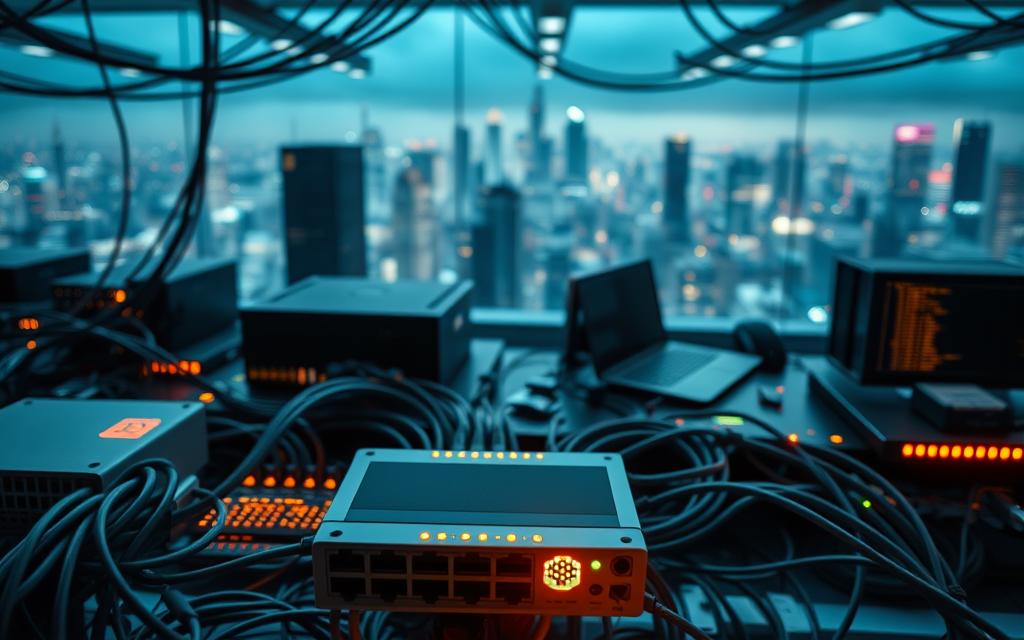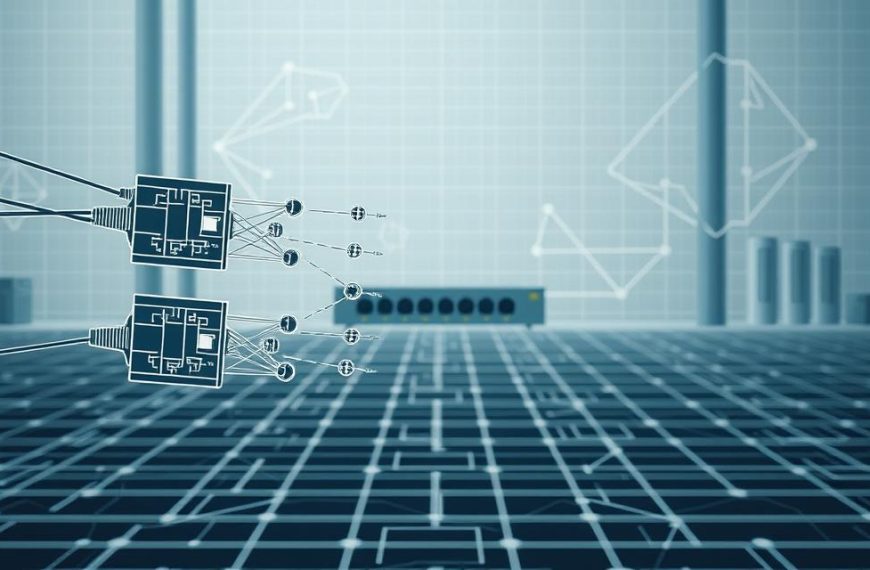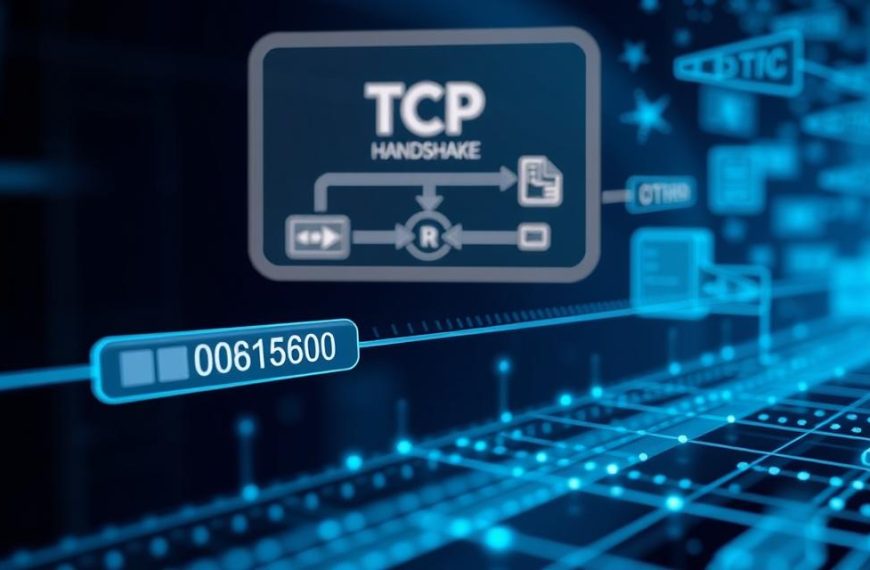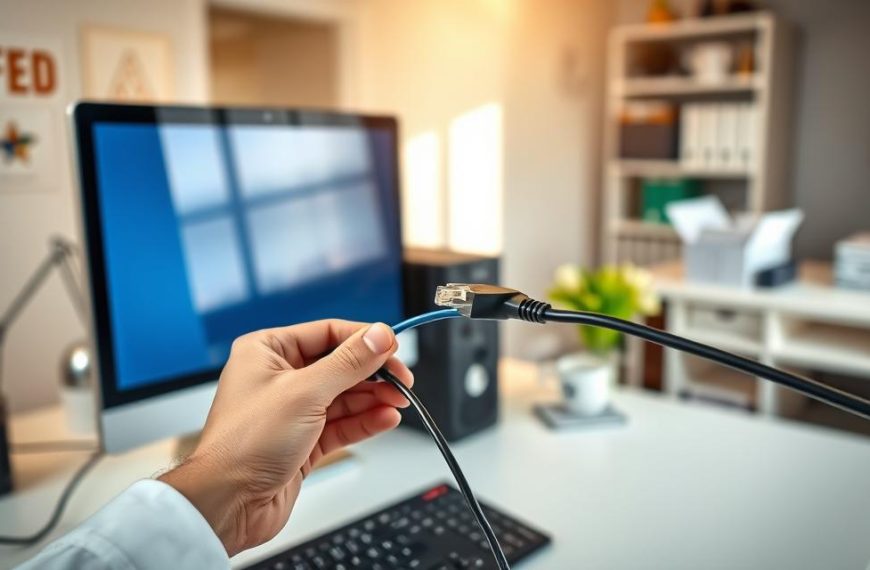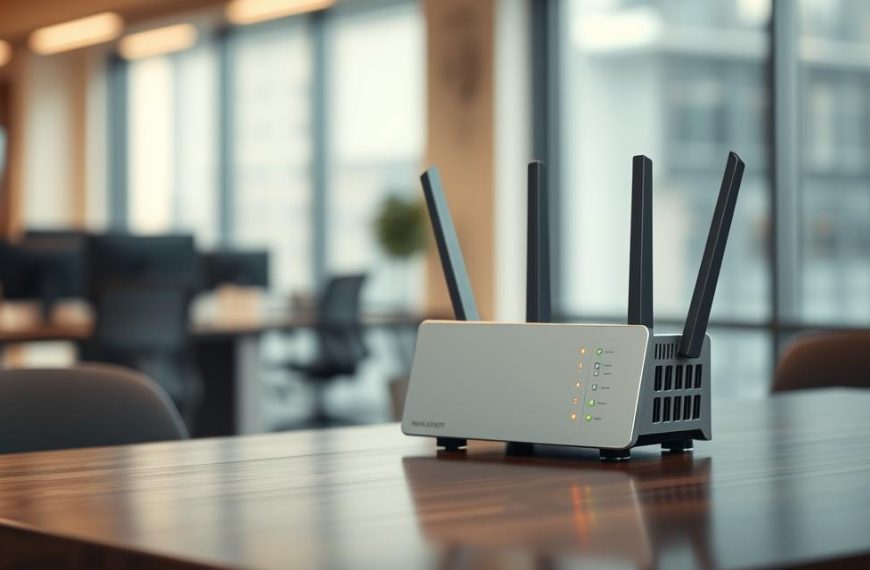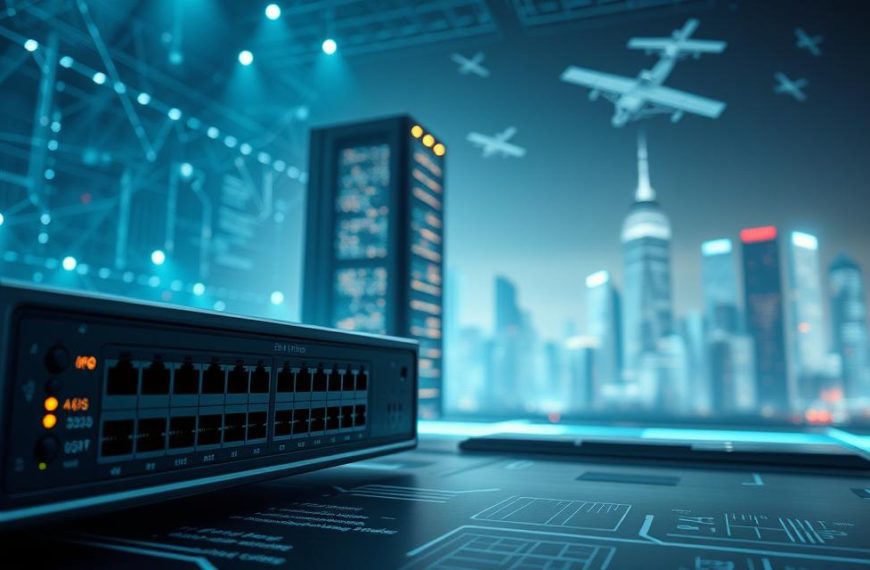A computer network definition is about systems linked together to share resources. These digital setups help different hardware parts talk to each other smoothly.
Today’s networking basics include servers, printers, and computers sharing data. This connection is key for tasks like sending emails and surfing the web.
The main goal is to share resources among connected devices. Networks are vital for today’s digital world in businesses.
Knowing these basics is key to understanding how data moves between systems. It lays the groundwork for diving into more advanced network designs.
What is a network in computer terms?
A computer network is a complex digital system. It connects many devices to share information and resources. This system is key to modern digital communication, from simple file sharing to complex cloud computing.
Basic definition and purpose
A computer network is a group of computers, servers, and devices that talk to each other. They use set rules to share information and resources. This makes it easy to exchange data and access resources from different places.
The main network purpose is to make communication between devices smooth. It lets users share resources, send data, and work together, no matter where they are. Networks are vital for many digital services we use every day.
Today’s networks support many important tasks. These include:
- Accessing the World Wide Web
- Streaming digital media
- Using shared storage and servers
- Sharing devices like printers and scanners
- Chatting in real-time through email and messages
Key objectives of networking
The main networking goals are to improve connectivity and use resources well. These goals guide how networks are set up and run, in all kinds of places.
Key goals are:
- Facilitating communication between users and systems through reliable data transmission channels
- Enabling resource sharing of hardware devices, software applications, and storage capacity
- Providing remote access capabilities for distributed teams and mobile users
- Supporting collaborative environments through shared workspaces and simultaneous access
- Enabling distributed computing applications that leverage multiple system resources
These networking goals shape how organisations build their digital setups. The focus on sharing data and communication is at the heart of most network setups, from small offices to big companies.
Good network design focuses on these goals to make systems work well and grow. It’s important to balance making things easy to use with keeping them safe and secure.
Fundamental components of computer networks
Every computer network has key parts that work together. They help devices talk to each other. Knowing these network components is the first step to understanding how data moves.
Three main parts make up any network: nodes that send and receive info, paths that carry data, and devices that connect to the network.
Nodes: Devices and Endpoints
In network talk, nodes are any device that can join in on network chats. This nodes definition includes everything from personal items to big business tools.
There are many types of nodes:
- End-user devices: laptops, smartphones, tablets
- Peripheral equipment: printers, scanners, smart speakers
- Infrastructure devices: servers, routers, switches
- Emerging IoT devices: smart home sensors, wearable technology
Each node has its own address. This lets it send, receive, or pass on data packets. This system makes sure messages get to the right device.
Transmission Media: Wired and Wireless Connections
Transmission media are the paths that carry data between nodes. They come in physical or wireless forms. Each type has its own speed, reliability, and setup needs.
Wired connections are fast and stable, using cables. Ethernet cables are common for local networks. Fibre optic cables are faster for long-distance connections.
Wireless tech uses radio waves or infrared. Wi-Fi lets devices move freely within range. Bluetooth connects devices over short distances.
| Media Type | Maximum Speed | Typical Use Case | Installation Complexity |
|---|---|---|---|
| Ethernet (Cat 6) | 1 Gbps | Office networks | Moderate |
| Fibre Optic | 100 Gbps | Data centres | High |
| Wi-Fi 6 | 9.6 Gbps | Home/office wireless | Low |
| Bluetooth 5 | 2 Mbps | Personal devices | Very low |
Network Interfaces: NICs and Adapters
Network Interface Controllers (NICs) connect devices to the network. They turn digital info into signals for transmission.
Modern NICs do many important jobs:
- Media access control (MAC) address management
- Signal encoding and decoding
- Error detection and correction
- Protocol implementation
Network adapters are available in many shapes, like built-in parts, cards, or USB devices. Many devices now have NICs that work for both wired and wireless connections.
These three key network components work together to make networks work. Nodes send and get data, media carries it, and interfaces connect devices to the network.
Common network topologies and their characteristics
Network topologies show how devices connect in a network. They affect data flow, reliability, and system performance.
Each network topology has its own benefits and challenges. Companies choose based on needs for growth, cost, and redundancy.
Star Topology: Centralised Connectivity
The star network has all devices linked to a central hub or switch. This setup makes each connection point-to-point to the hub.
Superior fault isolation is a key benefit. If one connection fails, others keep working. It also makes network management easier.
But, the central hub is a single point of failure. If it breaks, the whole network stops. Despite this, star networks are popular for their simplicity.
Bus Topology: Linear Network Structure
In a bus network, devices connect to a single cable called the backbone. This setup uses one channel for all data.
Cost-effective implementation is a big plus. It needs less cable and is good for small networks.
The main issue is collision risk. All devices share the same channel, leading to data collisions. As more devices join, network performance can drop.
Mesh Topology: Redundant Pathways
Mesh networks have many paths between nodes, making them highly connected. They come in full and partial mesh types.
The main advantage is exceptional reliability and redundancy. If a path fails, data finds another way. This is great for critical systems needing constant connection.
The big challenge is complexity. Many connections mean lots of cabling and setup work. This makes mesh networks more expensive.
Companies must consider these points when setting up their networks. The right choice depends on their needs and budget.
Key network protocols: TCP/IP and beyond
Every successful network communication relies on specific rules. These rules, called network protocols, help different systems talk to each other. They make sure systems with different hardware or software can work together.
TCP/IP Protocol Suite Fundamentals
The TCP/IP basics are key to modern internet use. It has four layers that work together well. The network access layer deals with physical connections. The internet layer handles addresses and routes.
The transport layer ensures data is delivered right. The application layer talks to user programs. Two transport layer protocols are TCP and UDP. TCP is for reliable, error-checked data. UDP is for fast, real-time data.
This layered system makes data transfer strong across different networks. Each layer adds its own info to the data package. This makes networks handle everything from local file transfers to global internet.
Other Essential Protocols: HTTP, FTP, SMTP
There are more protocols beyond TCP/IP. The HTTP protocol (Hypertext Transfer Protocol) is key for web browsing. It lets clients ask for web pages and servers send them. HTTP’s simple request-response model makes the web work.
The FTP protocol (File Transfer Protocol) is for moving files. It uses two connections: one for commands and one for data. This way, files can be uploaded and downloaded efficiently.
Email uses SMTP (Simple Mail Transfer Protocol). It sends messages between mail servers. SMTP works with POP3 or IMAP to get messages from servers to devices.
These protocols show how specific rules enable internet services. They build on TCP/IP’s solid foundation. Knowing their roles helps us see how complex network communications work smoothly in our daily lives.
Types of networks: LAN, WAN, and other classifications
Networks are classified based on their size. This helps us understand how they work. Different network classifications are used to design systems for various needs and distances.
Local Area Networks (LANs): Connecting Nearby Devices
Local Area Networks, or LAN networks, link devices in a small area. They are found in offices, schools, or buildings. LANs are fast, making them great for sharing resources and data.
LANs use Ethernet cables or Wi-Fi. They let devices share printers, files, and internet. LANs are easier to manage and more secure than bigger networks.
Wide Area Networks (WANs): Spanning Large Distances
Wide Area Networks, or WAN networks, connect devices over long distances. They can cover cities, countries, or continents. WANs use leased lines, satellite links, or fibre optic cables.
WANs are slower than LANs because of the distance. They are key for connecting offices in different places. Internet providers also use WANs to reach homes and businesses.
Other Network Types: PAN, MAN, CAN
There are other network classifications too. Personal Area Networks (PANs) connect devices close to us, like with Bluetooth. PAN networks link smartphones and tablets.
Metropolitan Area Networks (MANs) cover a city. Campus Area Networks (CANs) link buildings in a university or corporate park. Each has its own benefits based on size and use.
Understanding these types is key for IT pros. It helps them choose the right network for the job. Check out this guide for more.
| Network Type | Coverage Area | Typical Speed | Common Applications |
|---|---|---|---|
| PAN | Personal space (10m) | 2 Mbps – 24 Mbps | Device pairing, peripherals |
| LAN | Building/campus | 100 Mbps – 10 Gbps | Office networks, schools |
| CAN | Multiple buildings | 1 Gbps – 10 Gbps | University campuses |
| MAN | City-wide | 10 Mbps – 100 Mbps | City services, ISP networks |
| WAN | Country/global | 1 Mbps – 10 Mbps | Corporate networks, internet |
Different networks balance size with speed. Companies use many types to meet both local and wide-area needs. This creates a strong communication system.
Network hardware: Essential devices for connectivity
Every computer network has special hardware working together. These devices are key to digital communication. They help move data across different networks.
Routers: Directing Traffic Between Networks
Routers act as smart traffic controllers at network edges. They check data packets and find the best paths between networks. This is done using routing tables and protocols.
The main routers function is to decide where data goes based on IP addresses. Routers keep up with network paths. This ensures data gets to its right place across networks.
Today’s routers also have extra features:
- Built-in firewalls for basic security
- Wireless access point capabilities
- Quality of Service (QoS) prioritisation
- Network address translation (NAT) functionality
Switches: Managing Internal Network Traffic
Switches handle traffic within local networks. They don’t just send data to all devices like hubs do. Instead, they send it only to the right device.
The main switches function is based on MAC address recognition. Switches learn which devices are connected. This makes networks more efficient and cuts down on unnecessary traffic.
Big switches have extra features:
- VLAN support for network segmentation
- Power over Ethernet (PoE) for connected devices
- Link aggregation for bandwidth combining
- Quality of Service settings for traffic prioritisation
Modems: Connecting to Internet Service Providers
Modems translate digital networks into analogue signals. They change digital signals from computers into formats for phone or cable lines.
The main modems purpose is to modulate and demodulate signals. Modems turn digital data into analogue signals for sending. Then, they change it back for receiving data.
There are different modem types for various connections:
- DSL modems for telephone line internet
- Cable modems for coaxial cable connections
- Fibre optic modems for high-speed fibre networks
- Cellular modems for mobile broadband access
Routers, switches, and modems are key to network infrastructure. Knowing their roles helps in setting up, fixing, and improving computer networks for many uses.
Network security considerations and best practices
Keeping digital assets safe needs strong network security plans. These plans must tackle both outside and inside risks. Companies should use many layers of defence to protect important data and keep things running smoothly.
Common Network Threats and Vulnerabilities
Today’s networks face many network threats that can harm data and make systems unavailable. Knowing these risks is key to protecting well.
Some big vulnerabilities are:
- Unauthorised access attempts through weak authentication
- Malware infections including ransomware and spyware
- Denial-of-service attacks disrupting network operations
- Data interception during transmission
- Insider threats from compromised credentials
Essential Security Measures: Firewalls and Encryption
Good network security starts with basic protection tools. These tools help build strong defence layers.
Firewalls act as guards, checking and controlling network traffic. They block bad traffic and let good traffic through.
Encryption makes data unreadable during sending, keeping it safe from prying eyes. This is key for keeping sensitive info safe.
| Security Measure | Primary Function | Implementation Level |
|---|---|---|
| Firewalls | Traffic filtering and monitoring | Network perimeter |
| Encryption | Data protection during transmission | Data layer |
| Authentication Systems | User identity verification | Access point |
| Access Controls | Permission management | System level |
More security steps include using multi-factor authentication, keeping software up to date, and training staff. These steps help make network security stronger against new network threats.
Conclusion
Computer networks are key to our digital world. They help us talk to each other and share data everywhere. This summary shows how devices and protocols work together to make our digital world strong.
Networking is very important today. Knowing about networks helps companies work better and keep their data safe. Good network design lets everyone share resources and keep data safe.
Future networks will get even better with new tech like software-defined networking. These changes will make networks more flexible and automated. But, keeping data safe will be more important than ever as we use more devices and work from home.
Networks change how we get information and work together. As we rely more on digital things, knowing about networks becomes even more valuable. This is true for IT experts and companies all over the world.

